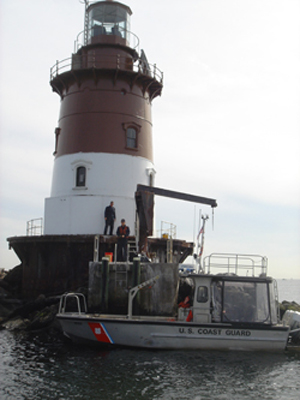Great Beds And Romer Shoal Lighthouses For Sale Off New Jersey
SOUTH AMBOY, NJ (CBSNewYork / AP) - There are two real estate listings you should know about, but they're not the average homes for sale.
WCBS 880's Levon Putney: You're Going To Need A Boat
Podcast
"Both of them are off the coast of northern New Jersey," says U.S. General Services Administration spokesperson Renee Miscione.
Yes, you read that correctly - OFF the coast.
The Great Beds Lighthouse, which is about a mile off the Raritan Bay coast, and the Romer Shoal Lighthouse, which is some four miles north of Sandy Hook, will be auctioned to the highest bidder.
Both are listed on the National Register of Historic Places.
Whoever places the winning bid on Great Beds Lighthouse could join the ranks of Uriah Seely, Phineas Mundy and Mortimer Wood as people who have lived in the historic five-story tower.
The men were keepers of Great Beds Lighthouse in the late 1800s. They earned about $600 a year for maintaining the lighthouse and keeping the lamp lit.
Today, the navigational aid is automated and solar-powered. Nobody has lived in the lighthouse for decades.
"It's a unique opportunity. I mean, there are only so many lighthouses," Miscione says.
They're holding an open house of sorts in early June for interested buyers, who'd better have a boat, or, as Miscione says (jokingly), "if you're a good swimmer."
"There are many people who buy them for vacation purposes," she says.
Boaters and those interested in restoration work also are drawn to the historic lighthouses, she said.
Miscione said recent offshore lighthouse sales include West Bank Light in New York ($195,000), Ram Island Ledge Light in Maine ($190,000), Cleveland Ledge Light in Massachusetts ($190,000) and Old Orchard Light in New York ($95,000). Other lighthouses have been transferred to nonprofits and local agencies to be turned into museums and tourist destinations, she said. Great Beds and Romer Shoal are being auctioned off because the government was not able to find other organizations to maintain them.
Under the National Historic Lighthouse Preservation Act of 2000, the General Services Administration has transferred to other agencies or sold at auction about 60 lighthouses because the federal government does not need them anymore. They still use the lights as navigational aids, but do not need employees living inside.
According to the government's invitation for bids, potential Great Beds or Romer Shoal lighthouse buyers ought to be aware of some possible issues: A boat is needed to get to the lighthouses. There is some guano inside and outside the lighthouses. The structures are subject to flooding from tidal surges. There are no utilities. The federal government needs to stop by every few months to tend to the navigational equipment, which the government still will own. Because it's a historic site and the navigational equipment will remain there, there are limits to what renovations can be made. At Romer Shoal, some original wood floorboards on the second floor are rotting. Romer Shoal also has a fog signal that sounds a two-second blast every 15 seconds.
People who post $10,000 to register as bidders will be invited to inspect the two New Jersey lighthouses in early June. So far, there are three registered bidders. Two of the prospective bidders are interested in both lighthouses and will decide after the inspections on which lighthouse they want to bid. One person is interested only in Great Beds, Miscione said.
Tending to the lighthouses could be lonely and dangerous work. Two men - George Brennen and John E. Johnson - were believed to have drowned months apart in 1883 during their tenure as keepers at Great Beds.
In 1920, a naval employee drowned while attempting to bring supplies to Romer Shoal. And one Great Beds keeper reportedly bought ads to find a wife while he was living in the lighthouse.
In 1918, an explosion at a munitions plant in Morgan broke the glass around the Great Beds lighthouse lamp and keeper George W. Denton Jr. stayed up to ensure the light was lighted.
"The broken windows caused the signal light to be extinguished six times during the subsequent night,'' according to Great Beds' nomination to the National Register of Historic Places. "Keeper George W. Denton Jr. stayed in the lantern throughout the ordeal, watching the lens and relighting the lamps whenever necessary. Denton later received a commendation for his valiant effort to keep the light lit throughout the night.''
(TM and Copyright 2011 CBS Radio Inc. and its relevant subsidiaries. CBS RADIO and EYE Logo TM and Copyright 2011 CBS Broadcasting Inc. Used under license. All Rights Reserved. This material may not be published, broadcast, rewritten, or redistributed. The Associated Press contributed to this report.)




